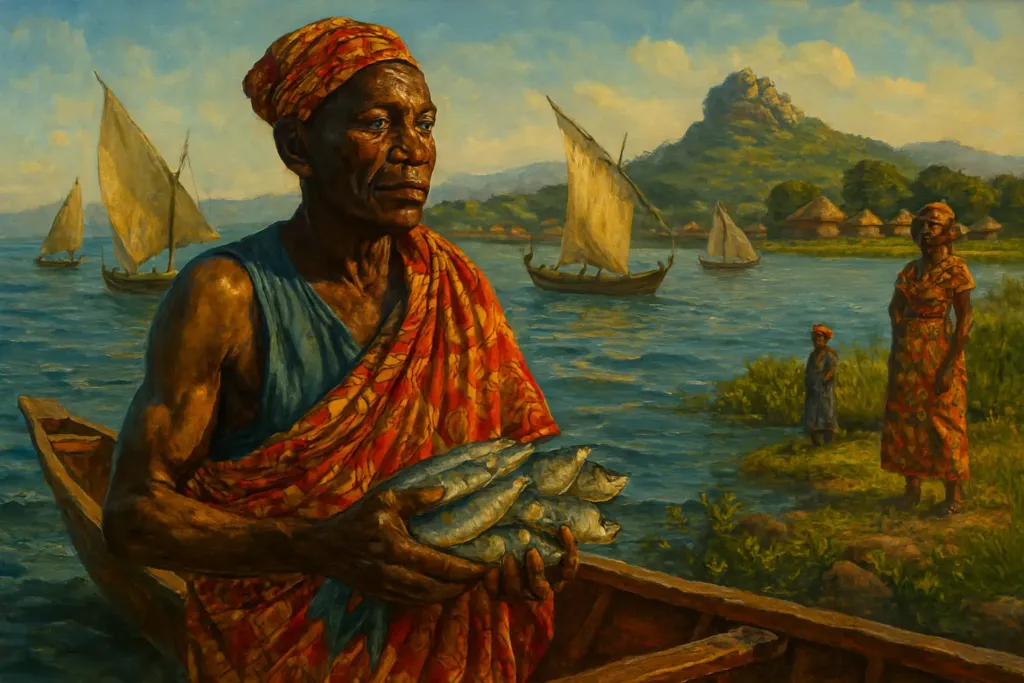The Luo (endonym Joluo; language Dholuo) are a Nilotic people of western Kenya centered around Winam Gulf and Kisumu. Multilingualism is common: Dholuo at home, Swahili and English in education and trade. Christianity (Protestant and Catholic) predominates, alongside elements of ancestral beliefs and rites. Social life rests on patrilineal clans and respect for elders; councils (baraza) mediate decisions. Hospitality, frank speech and communal responsibility are valued; labeling an entire people as “aggressive” or “friendly” is inaccurate—behavior is situational. Attitudes to alcohol vary; traditional brews exist, while public regulations and norms emphasize moderation. Popular pursuits include football (historically Gor Mahia), athletics, and traditional music and dance. Formal governance follows Kenyan administrative structures; locally, senior household heads and respected opinion leaders carry weight.
History
Ancestors of the Luo migrated from the Upper Nile through northern Uganda to the eastern shores of Lake Victoria in the 15th–17th centuries. Under British rule, missions, schools and roads reshaped the region, expanding fishing and cash-crop linkages. In the 20th century, Luo communities were prominent in education, labor organizing and national politics. Postwar urbanization tied rural dala homesteads to Kisumu and Nairobi and strengthened diaspora networks.
Name
Endonym Joluo (“people of Luo”); the language is Dholuo (“speech of Luo”). The ethnonym belongs to the Southern Luo branch of Nilotic peoples; oral tradition venerates the founding ancestor Ramogi as a unifying figure.
Occupations
Historically: lake fishing (tilapia, omena), farming (millet, sorghum, later maize), herding in drier zones, blacksmithing and boatbuilding. Today: mixed livelihoods—farming and fisheries, trade and services, public sector, teaching, health care, small enterprises and urban migration.
Physical description
Luo belong to East African Nilotic populations with wide phenotypic diversity. Average stature and build vary by area; there are no fixed “racial” traits, and biological generalizations are unwarranted.
Distribution
Historically: western Kenya (present-day Kisumu, Siaya, Homa Bay, Migori) and adjacent Tanzanian lakeshore. Today: strong presence in Kenyan cities (Kisumu, Nairobi, Mombasa) and smaller communities in Tanzania and Uganda.
Wars and conflicts
Precolonial life included episodic cattle raids and border skirmishes with neighbors; colonial “pacification” followed. In independent Kenya, tension has sometimes spiked around elections; Luo communities, like others, experienced violence episodes followed by reconciliation efforts, civic dialogue and reforms. Intra-community disputes typically involve land, inheritance and local leadership.
Population
The Luo are among Kenya’s largest communities. Estimates range roughly from 4–5 million in Kenya, with several hundred thousand in Tanzania and smaller groups in Uganda. Since the mid-20th century, overall numbers have grown due to natural increase and improved access to schooling and health care, while the urban share has risen via migration.
Traditions, rites, festivals
Core elements include the dala homestead layout, veneration of ancestors, marriage negotiations and bridewealth, communal feasts with music and dance. Widow-care and cleansing rites existed historically and are being reinterpreted today. Funerals are major public events with songs, elder orations and burial within family land; specifics depend on denomination and family custom. Contemporary festivals in Kisumu and Nairobi showcase benga music and the nyatiti lyre.
Myths and legends
Central is the Ramogi ancestor and the journey to the “great water.” Kit-Mikayi, the sacred rock near Kisumu, is surrounded by tales of love, patience and clan blessing. Lakeside lore links lake behavior with moral lessons and cautions.
Notability
Notable Luo include writer Grace Ogot; musicians Ayub Ogada and D.O. Misiani (benga pioneers); actress Lupita Nyong’o (of Kenyan Luo heritage); civic leaders from the Oginga–Odinga family; and economist Barack Obama Sr. Gor Mahia FC, with a strong Luo supporter base, is one of Kenya’s most decorated football clubs. Literature and art frequently depict the lake, fishing lifeways and Kisumu’s urban culture.
Food
Staples include kuon/ugali (maize meal), fish (tilapia, omena), legumes, leafy greens (sukuma, osuga) and tomato- or groundnut-based sauces. Dried omena, stewed fish and vegetable ragouts are common; urban diets blend wider Kenyan fare.
Clothing
Everyday dress is contemporary; festive attire features bright kitenge/kanga fabrics, beadwork and headwraps. Men and women mix traditional motifs with business wear; benga performers’ costumes emphasize regional identity.
Tourism
Highlights include Kisumu Museum (ethnographic displays and a traditional homestead), Kit-Mikayi rock, Ndere Island, Dunga Beach and Winam Bay boardwalks, and memorial sites of community leaders. Visitors can explore craft workshops, fish markets and festivals, and attend nyatiti masterclasses.
Etiquette for visitors
Greet in Dholuo/Swahili, show deference to elders and family customs. Ask before photographing people or homes; avoid intrusive political debates; dress modestly in rural areas. Small hostess gifts are appreciated; avoid passing items with the left hand. Negotiations are calm; rural timekeeping is flexible.
- Mtsyri: tracing Lermontov in Mtskheta
- Tuareg
- Kamchatka
- Travel to Cambodia
- Tragic Geography: Tourist Sites with the Highest Death Toll
- Istanbulkart Scams: What Tourists Should Watch Out For
- Turkmenistan
- Barbados
- Facts and tips about sharks
- Rhino Poaching Crisis Threatens Biodiversity and National Identity
- Kyrgyzstan
- 9 Reasons Why People Love to Travel to Other Countries
- Chukchi
- Tourist safety in Bukhara: how to spot and avoid crime
- Traveling to Russia
- Ratmanov Island
- Treasure in the Cape Cod fog: A Thai traveler’s encounter with pirate history
- Nicaragua
- Namibia sees almost double-digit growth
- Zulfiqar: The Legendary Sword and a Tourist Symbol of the Islamic World











